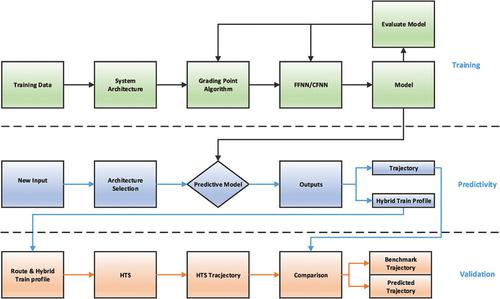当前位置:
X-MOL 学术
›
IET Intell. Transp. Syst.
›
论文详情
Our official English website, www.x-mol.net, welcomes your feedback! (Note: you will need to create a separate account there.)
Prediction of the optimal hybrid train trajectory by using artificial neural network models
IET Intelligent Transport Systems ( IF 2.7 ) Pub Date : 2024-01-02 , DOI: 10.1049/itr2.12472 Tajud Din 1 , Zhongbei Tian 1 , Syed Muhammad Ali Mansur Bukhari 2 , Misbahud Din 2 , Stuart Hillmansen 1 , Clive Roberts 1
IET Intelligent Transport Systems ( IF 2.7 ) Pub Date : 2024-01-02 , DOI: 10.1049/itr2.12472 Tajud Din 1 , Zhongbei Tian 1 , Syed Muhammad Ali Mansur Bukhari 2 , Misbahud Din 2 , Stuart Hillmansen 1 , Clive Roberts 1
Affiliation

|
This paper presents the development and validation of two artificial neural networks (ANN) models, utilising time and power-based architectures, to accurately predict key parameters of a hydrogen hybrid train profile and its optimal trajectory. The research employs a hybrid train simulator (HTS) to authenticate the ANN models, which were trained using simulated trajectories from five unique hybrid trains on a designated route. The models’ performance was evaluated by computing the mean square normalisation error and mean absolute performance error, while the output's reliability was confirmed through the HTS. The results indicate that both ANN models proficiently predict a hybrid train's critical parameters and trajectory, with mean errors ranging from 0.19% to 0.21%. However, the cascade-forward neural network (CFNN) topology in the time-based architecture surpasses the feed-forward neural network (FFNN) topology concerning mean squared error (MSE) and maximum error in the power-based architecture. Specifically, the CFNN topology within the time-based structure exhibits a slightly lower MSE and maximum error than its power-based counterpart. Additionally, the study reveals the average percentage difference between the benchmark and FFNN/CNFN trajectories, highlighting that the time-based architecture exhibits lower differences (0.18% and 0.85%) compared to the power-based architecture (0.46% and 0.92%).
中文翻译:

使用人工神经网络模型预测最佳混合列车轨迹
本文介绍了两种人工神经网络 (ANN) 模型的开发和验证,利用基于时间和功率的架构,准确预测氢混合动力列车轮廓的关键参数及其最佳轨迹。该研究采用混合列车模拟器 (HTS) 来验证 ANN 模型,该模型使用指定路线上五列独特混合列车的模拟轨迹进行训练。通过计算均方归一化误差和平均绝对性能误差来评估模型的性能,同时通过 HTS 确认输出的可靠性。结果表明,两种 ANN 模型都能熟练地预测混合列车的关键参数和轨迹,平均误差范围为 0.19% 至 0.21%。然而,基于时间的架构中的级联前向神经网络(CFNN)拓扑在基于功率的架构中的均方误差(MSE)和最大误差方面优于前馈神经网络(FFNN)拓扑。具体来说,基于时间的结构中的 CFNN 拓扑比基于功率的结构表现出略低的 MSE 和最大误差。此外,该研究还揭示了基准和 FFNN/CNFN 轨迹之间的平均百分比差异,强调与基于功率的架构(0.46% 和 0.92%)相比,基于时间的架构表现出较低的差异(0.18% 和 0.85%)。
更新日期:2024-01-05
中文翻译:

使用人工神经网络模型预测最佳混合列车轨迹
本文介绍了两种人工神经网络 (ANN) 模型的开发和验证,利用基于时间和功率的架构,准确预测氢混合动力列车轮廓的关键参数及其最佳轨迹。该研究采用混合列车模拟器 (HTS) 来验证 ANN 模型,该模型使用指定路线上五列独特混合列车的模拟轨迹进行训练。通过计算均方归一化误差和平均绝对性能误差来评估模型的性能,同时通过 HTS 确认输出的可靠性。结果表明,两种 ANN 模型都能熟练地预测混合列车的关键参数和轨迹,平均误差范围为 0.19% 至 0.21%。然而,基于时间的架构中的级联前向神经网络(CFNN)拓扑在基于功率的架构中的均方误差(MSE)和最大误差方面优于前馈神经网络(FFNN)拓扑。具体来说,基于时间的结构中的 CFNN 拓扑比基于功率的结构表现出略低的 MSE 和最大误差。此外,该研究还揭示了基准和 FFNN/CNFN 轨迹之间的平均百分比差异,强调与基于功率的架构(0.46% 和 0.92%)相比,基于时间的架构表现出较低的差异(0.18% 和 0.85%)。



























 京公网安备 11010802027423号
京公网安备 11010802027423号